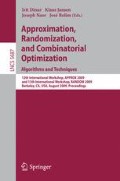Abstract
Zimand [24] presented simple constructions of locally computable strong extractors whose analysis relies on the direct product theorem for one-way functions and on the Blum-Micali-Yao generator. For N-bit sources of entropy γN, his extractor has seed O(log2 N) and extracts N γ/3 random bits.
We show that his construction can be analyzed based solely on the direct product theorem for general functions. Using the direct product theorem of Impagliazzo et al. [6], we show that Zimand’s construction can extract \(\tilde \Omega_\gamma (N^{1/3}) \) random bits. (As in Zimand’s construction, the seed length is O(log2 N) bits.)
We also show that a simplified construction can be analyzed based solely on the XOR lemma. Using Levin’s proof of the XOR lemma [8], we provide an alternative simpler construction of a locally computable extractor with seed length O(log2 N) and output length \(\tilde \Omega_\gamma (N^{1/3})\).
Finally, we show that the derandomized direct product theorem of Impagliazzo and Wigderson [7] can be used to derive a locally computable extractor construction with O(logN) seed length and \(\tilde \Omega (N^{1/5})\) output length. Zimand describes a construction with O(logN) seed length and \(O(2^{\sqrt{\log N}})\) output length.
Access this chapter
Tax calculation will be finalised at checkout
Purchases are for personal use only
Preview
Unable to display preview. Download preview PDF.
References
Aumann, Y., Ding, Y.Z., Rabin, M.O.: Everlasting security in the bounded storage model. IEEE Transactions on Information Theory 48(6), 1668–1680 (2002)
Bar-Yossef, Z., Reingold, O., Shaltiel, R., Trevisan, L.: Streaming computation of combinatorial objects. In: Proceedings of the 17th IEEE Conference on Computational Complexity, pp. 165–174 (2002)
Blum, M., Micali, S.: How to generate cryptographically strong sequences of pseudorandom bits. SIAM Journal on Computing 13(4), 850–864 (1984); Preliminary version in Proc. of FOCS 1982
Dziembowski, S., Maurer, U.: Optimal randomizer efficiency in the bounded-storage model. Journal of Cryptology 17(1), 5–26 (2004); Preliminary version in Proc. of STOC 2002
Goldreich, O., Nisan, N., Wigderson, A.: On Yao’s XOR lemma. Technical Report TR95-50, Electronic Colloquium on Computational Complexity (1995)
Impagliazzo, R., Jaiswal, R., Kabanets, V., Wigderson, A.: Direct product theorems: Simplified, Optimized and Derandomized. In: Proceedings of the 40th ACM Symposium on Theory of Computing, pp. 579–588 (2008)
Impagliazzo, R., Wigderson, A.: P = BPP unless E has sub-exponential circuits. In: Proceedings of the 29th ACM Symposium on Theory of Computing, pp. 220–229 (1997)
Levin, L.: One-way functions and pseudorandom generators. Combinatorica 7(4), 357–363 (1987)
Lu, C.-J.: Encryption against storage-bounded adversaries from on-line strong extractors. Journal of Cryptology 17(1), 27–42 (2004)
Maurer, U.M.: Conditionally-perfect secrecy and a provably-secure randomized cipher. J. Cryptology 5(1), 53–66 (1992)
Nisan, N.: Extracting randomness: How and why. In: Proceedings of the 11th IEEE Conference on Computational Complexity, pp. 44–58 (1996)
Nisan, N., Ta-Shma, A.: Extrating randomness: A survey and new constructions. Journal of Computer and System Sciences (1998) (to appear); Preliminary versions in [11, 18]
Nisan, N., Zuckerman, D.: More deterministic simulation in Logspace. In: Proceedings of the 25th ACM Symposium on Theory of Computing, pp. 235–244 (1993)
Nisan, N., Wigderson, A.: Hardness vs randomness. Journal of Computer and System Sciences 49, 149–167 (1994); Preliminary version in Proc. of FOCS 1988
Nisan, N., Zuckerman, D.: Randomness is linear in space. Journal of Computer and System Sciences 52(1), 43–52 (1996); Preliminary version in Proc. of STOC 1993
Shaltiel, R.: Recent developments in extractors. Bulletin of the European Association for Theoretical Computer Science 77, 67–95 (2002)
Shaltiel, R., Umans, C.: Simple extractors for all min-entropies and a new pseudorandom generator. Journal of the ACM 52(2), 172–216 (2005)
Ta-Shma, A.: On extracting randomness from weak random sources. In: Proceedings of the 28th ACM Symposium on Theory of Computing, pp. 276–285 (1996)
Ta-Shma, A., Zuckerman, D., Safra, S.: Extractors from Reed-Muller codes. Technical Report TR01-036, Electronic Colloquium on Computational Complexity (2001)
Trevisan, L.: Extractors and pseudorandom generators. Journal of the ACM 48(4), 860–879 (2001)
Vadhan, S.P.: Constructing locally computable extractors and cryptosystems in the bounded-storage model. Journal of Cryptology 17(1), 43–77 (2004)
Viola, E.: The complexity of constructing pseudorandom generators from hard functions. Computational Complexity 13(3-4), 147–188 (2004)
Yao, A.C.: Theory and applications of trapdoor functions. In: Proceedings of the 23th IEEE Symposium on Foundations of Computer Science, pp. 80–91 (1982)
Zimand, M.: Simple Extractors via Constructions of Cryptographic Pseudo-random Generators. In: Caires, L., Italiano, G.F., Monteiro, L., Palamidessi, C., Yung, M. (eds.) ICALP 2005. LNCS, vol. 3580, pp. 115–127. Springer, Heidelberg (2005)
Zuckerman, D.: General weak random sources. In: Proceedings of the 31st IEEE Symposium on Foundations of Computer Science, pp. 534–543 (1990)
Zuckerman, D.: Simulating BPP using a general weak random source. Algorithmica 16(4/5), 367–391 (1996)
Author information
Authors and Affiliations
Editor information
Editors and Affiliations
Rights and permissions
Copyright information
© 2009 Springer-Verlag Berlin Heidelberg
About this paper
Cite this paper
De, A., Trevisan, L. (2009). Extractors Using Hardness Amplification. In: Dinur, I., Jansen, K., Naor, J., Rolim, J. (eds) Approximation, Randomization, and Combinatorial Optimization. Algorithms and Techniques. APPROX RANDOM 2009 2009. Lecture Notes in Computer Science, vol 5687. Springer, Berlin, Heidelberg. https://doi.org/10.1007/978-3-642-03685-9_35
Download citation
DOI: https://doi.org/10.1007/978-3-642-03685-9_35
Publisher Name: Springer, Berlin, Heidelberg
Print ISBN: 978-3-642-03684-2
Online ISBN: 978-3-642-03685-9
eBook Packages: Computer ScienceComputer Science (R0)

